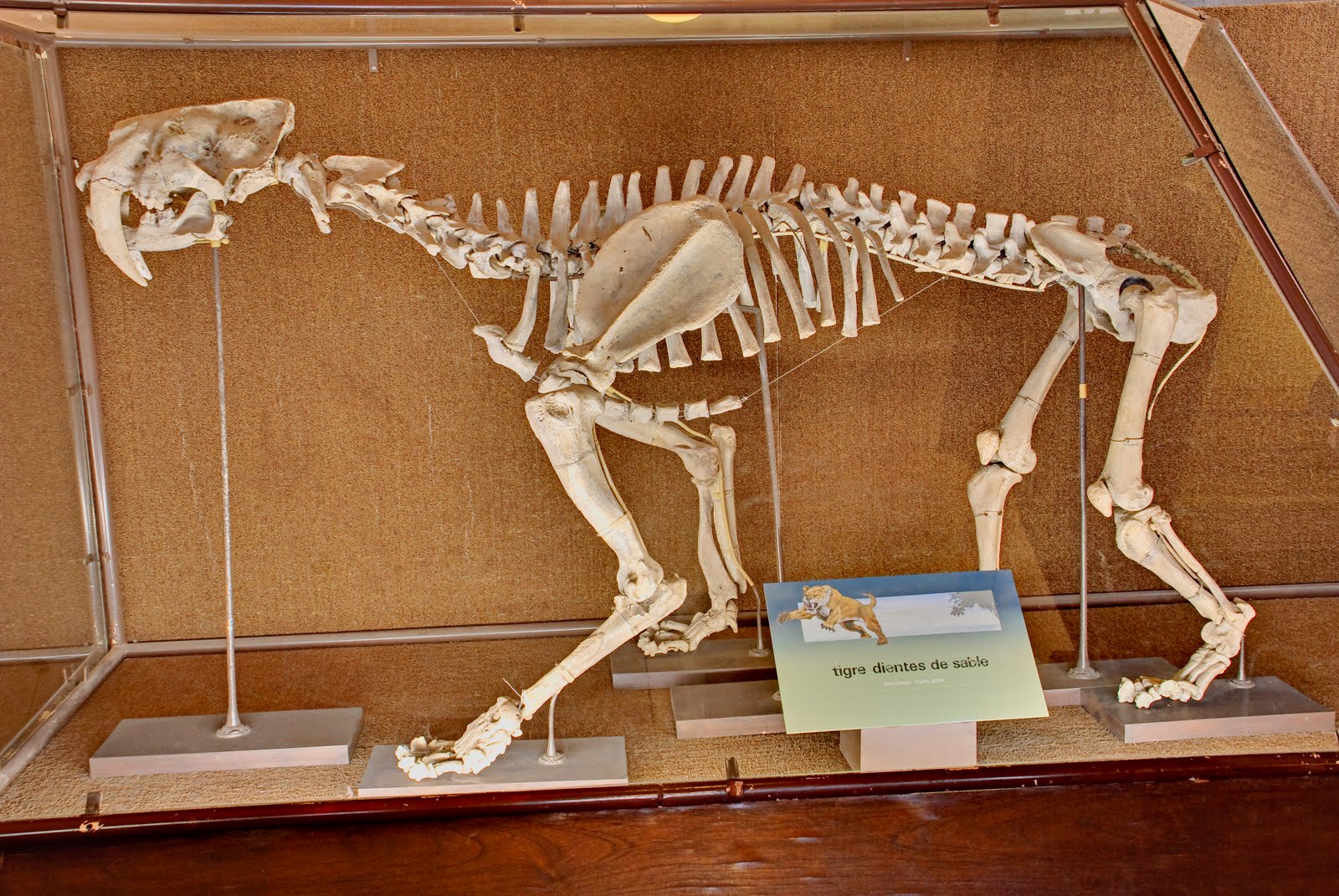Once upon a time, there lived on Earth intriguing animals generically called "saber-toothed cats". These creatures spread across several taxa (taxonomic categories such as suborders, families, subfamilies etc.). I will be focusing, however, on a particular saber-tooth: genus Smilodon.
Often incorrectly referred to as "the saber-toothed tiger", Smilodon belonged in fact to the now extinct subfamily Machairodontinae, whilst the tiger (Panthera tigris) is part of the Pantherinae subfamily – both within the Felidae family.
Smilodon lived throughout North and South America during the Pleistocene, from about 2.5 million years ago to about 10,000 years ago.
Genus Smilodon is officially comprised of three species:
Smilodon gracilis
- It is the earliest and smallest of the species
- It lived from about 2.5 million years ago to 500,000 years ago in today's North America
- It weighted 55-100 kg
- Its height ranged from 1-1.2 m
- Its canines could reach 18 cm in length
Smilodon fatalis
- It was slightly larger than S. gracilis
- It lived between 1.6 million years ago to 10,000 years ago in today's North America, then crossed over towards today's South America
- It weighted in average 130-200 kg
- Its height ranged from 1-1.2 m
- Its canines were about 18 cm in length
- It had sturdy front legs
- To my knowledge, both S. californicus and S. floridus are now considered subspecies of S. fatalis
Smilodon populator
- It was the largest of the Smilodon genus
- It lived from about 1 million years ago to about 10,000 years ago and it seems it first appeared in today's South America
- Its weight ranged from 220 to an impressive 470 kg (in males)
- Its height was of about 1.3 m
- Its ferocious saber teeth could reach 28 cm
- It had very strong front legs and chest
Anatomy
Such huge canine teeth required an impressive jaw mobility. Indeed, Smilodon could open its jaw to over 120 degrees (whereas the modern lion, for instance, can only open it at 65 degrees).
There is no sexual dimorphism in regards to canine teeth size (meaning that both male and female saber-toothed cats manifest no difference in canine length), thus invalidating the earlier assumption that suggested tooth size as a possible criteria of sexual selection.
Ecology
Those cute-looking kitties were fierce carnivores. Studies suggest that they hunted and lived in packs, much like modern lions' nowadays prides. Since they were not the only predators around, getting organized in social structures was beneficial, increasing the individuals' survival chances.
It was proposed that Smilodon's victims were
large, slow-moving, thick-skinned animals, such as mammoths and bison. Unable to kill its prey with a quick bite to the neck, the sabertooth cat probably inflicted deep wounds in the victim's flanks or hindquarters, and then simply waited for it to bleed to death.
(Dixon, D., Cox, B., Savage, R.J.G., and Gardiner, B., 1993, The Macmillan Illustrated Encyclopedia of Dinosaurs and Prehistoric Animals: A Visual Who's Who of Prehistoric Life, Macmillan Publishing Company)
The 2007 study Supermodeled sabercat, predatory behavior in Smilodon fatalis revealed by high-resolution 3D computer simulation suggests, however, that its bite strength was about a third than that of a modern feline of its size, due to the anatomical particularities of the jaws that had to accommodate such a large opening. It appears that Smilodon was a specialized hunter that used its massive size, robustness and well-developed chest and front legs musculature to bring down the large mammals that it preyed upon.
Only after the large herbivore was brought down, the saber-toothed cat applied a deep, stabbing bite in the prey's neck region (effectively immobilizing it until the animal bled to death).
Extinction
Smilodon unfortunately went extinct at the end of the last glaciation, some 10-12,000 years ago. The reasons are not yet reliably determined. There is, however, speculation regarding factors such as climate change, slower evolution rate and human activity. The changing environment might have been too harsh for the saber-toothed cats and they might have failed to adapt at the rate that would have ensured their survival. The climate change also induced variation in the vegetation pattern and therefore it might have diminished its prey in numbers. On the other hand, the large mammals might have managed to adapt faster, therefore winning the evolutionary arms race against the Smilodon. Humans may also have played a role in these predators' extinction, by extensively hunting the herbivores.
I deeply regret that these awesome carnivores are not alive today. They must have looked marvelous. Here is another reconstruction:
Suggested reading
- The Smilodon, Garrett Gyssler
- Wikipedia article
- Anton, M., and Turner, A., 2000, The Big Cats and Their Fossil Relatives. An Illustrated Guide to Their Evolution and Natural History, Columbia University Press
Image credits
- Figure 1: Dixon, D., Cox, B., Savage, R.J.G., and Gardiner, B., 1993, The Macmillan Illustrated Encyclopedia of Dinosaurs and Prehistoric Animals: A Visual Who's Who of Prehistoric Life, Macmillan Publishing Company
- Figure 2: Anton, M., and Turner, A., 2000, The Big Cats and Their Fossil Relatives. An Illustrated Guide to Their Evolution and Natural History, Columbia University Press
- Figure 3: Smithsonian Institution (1993), via Illinois State Museum
- Figure 4: Wikipedia
- Figure 5: Wikipedia
- Figure 6: Bone Clones (2004)
- Figure 7: Carnivora Forum











No comments:
Post a Comment